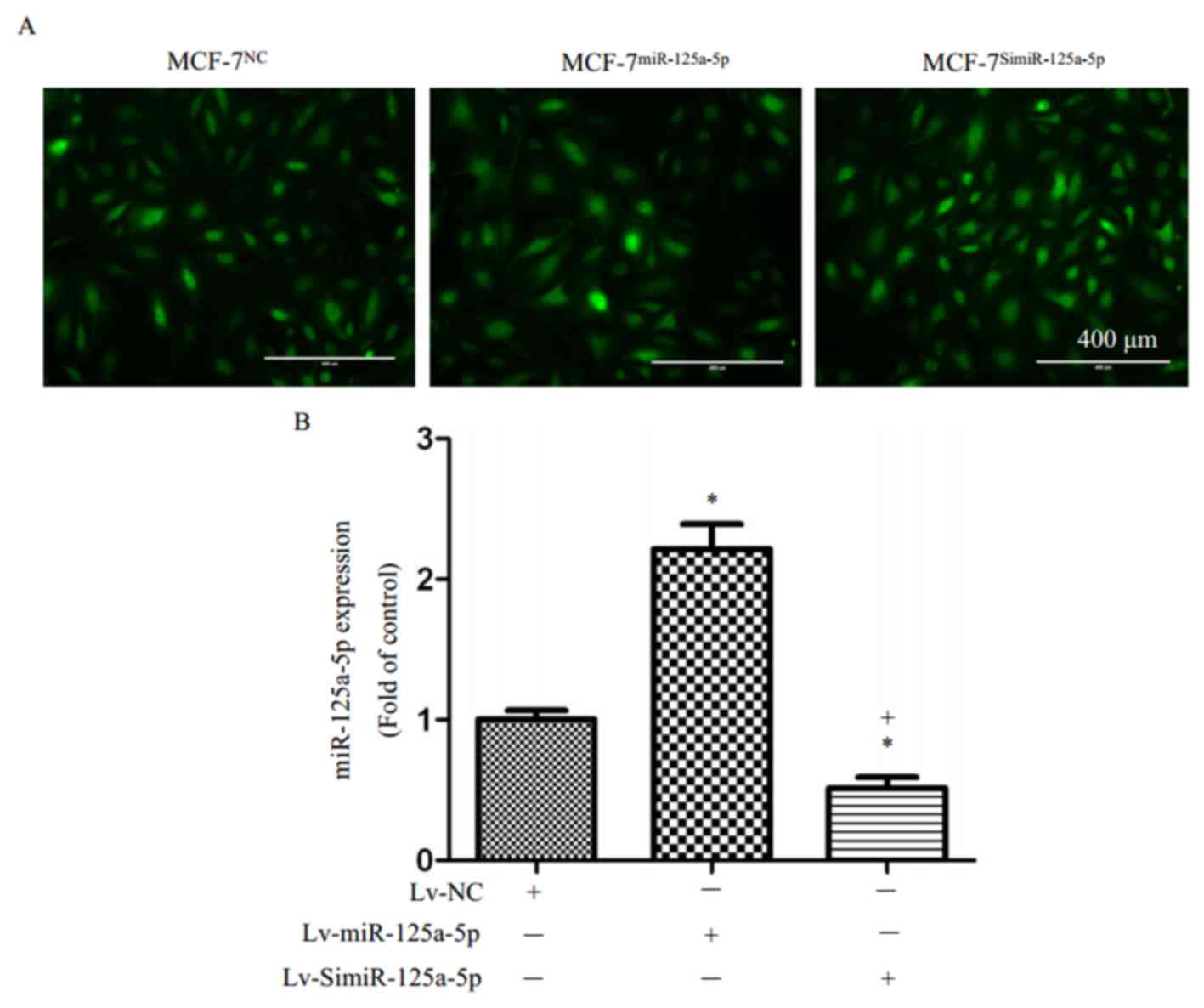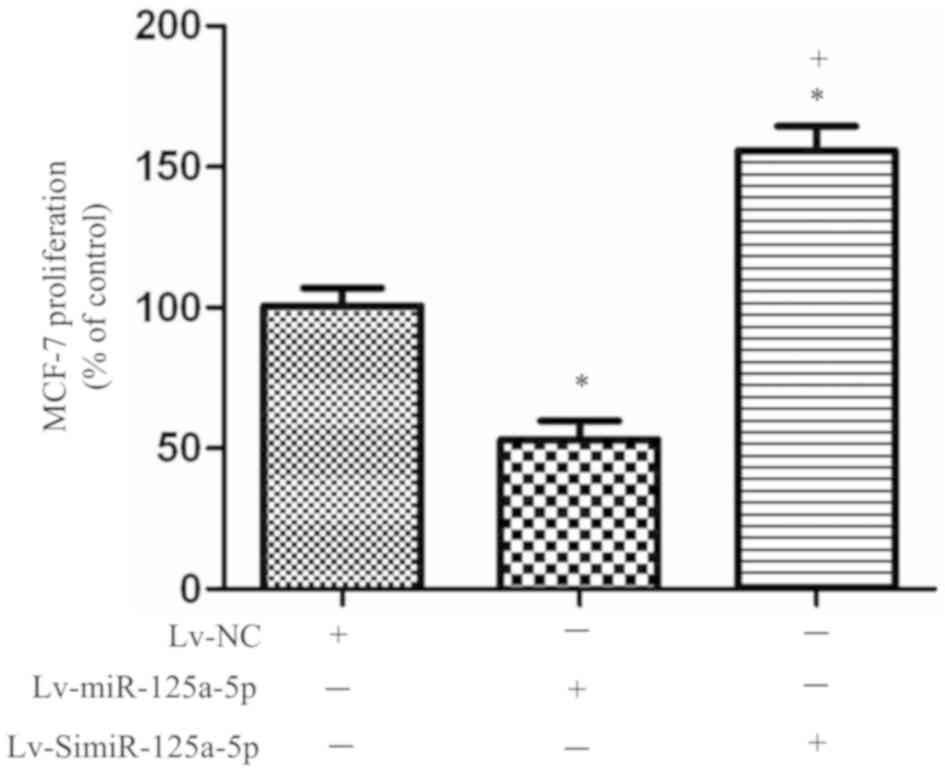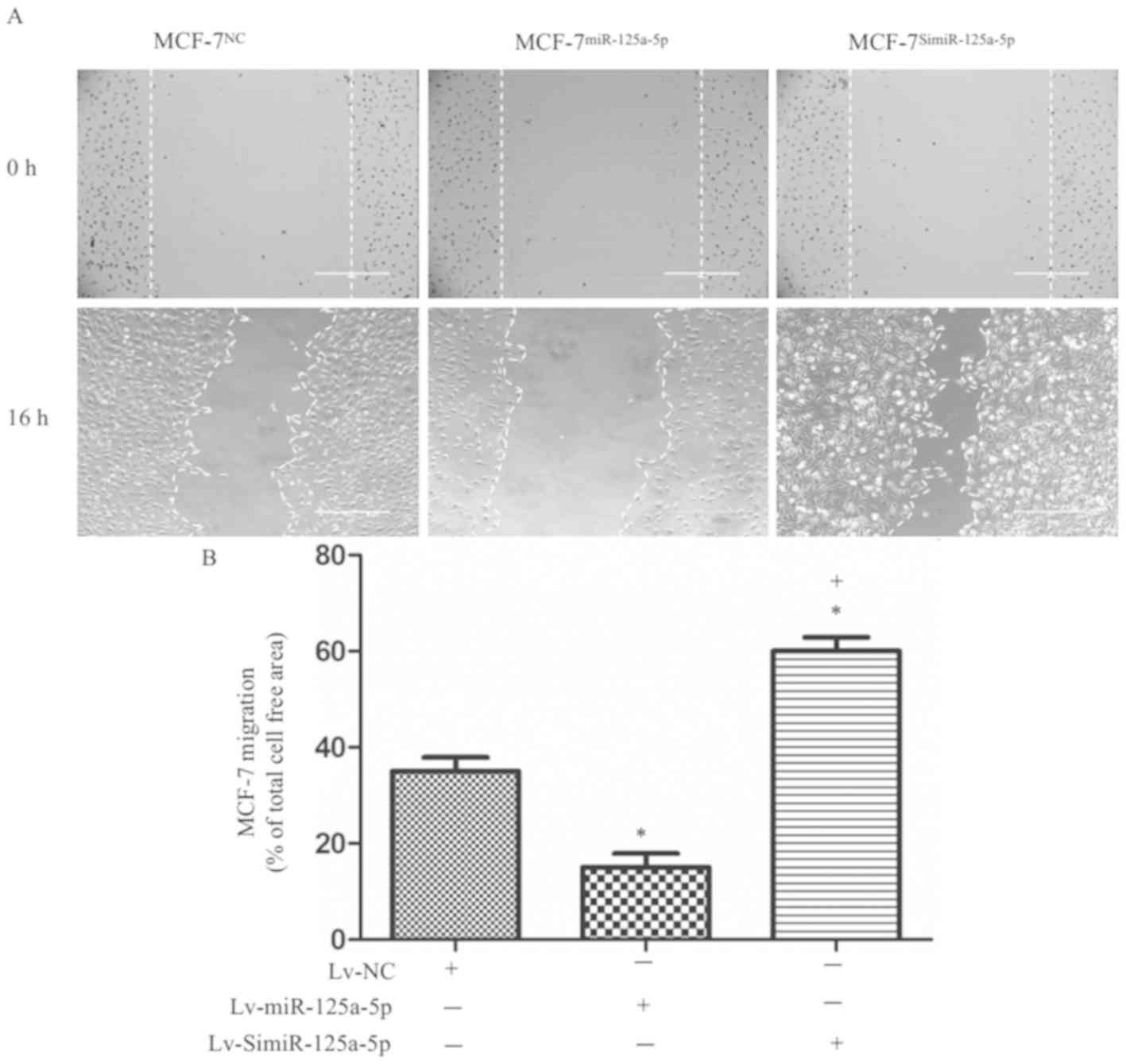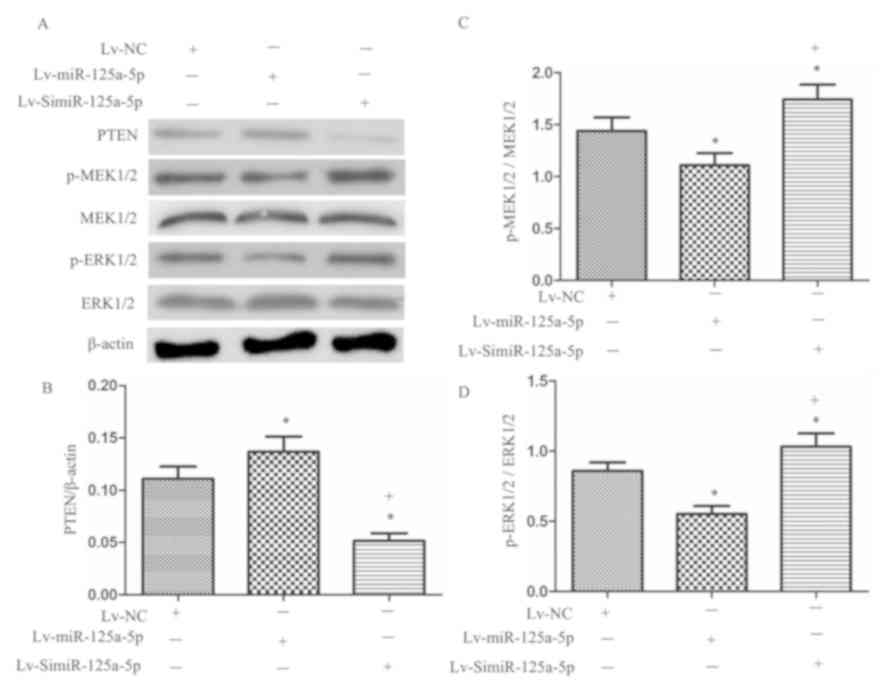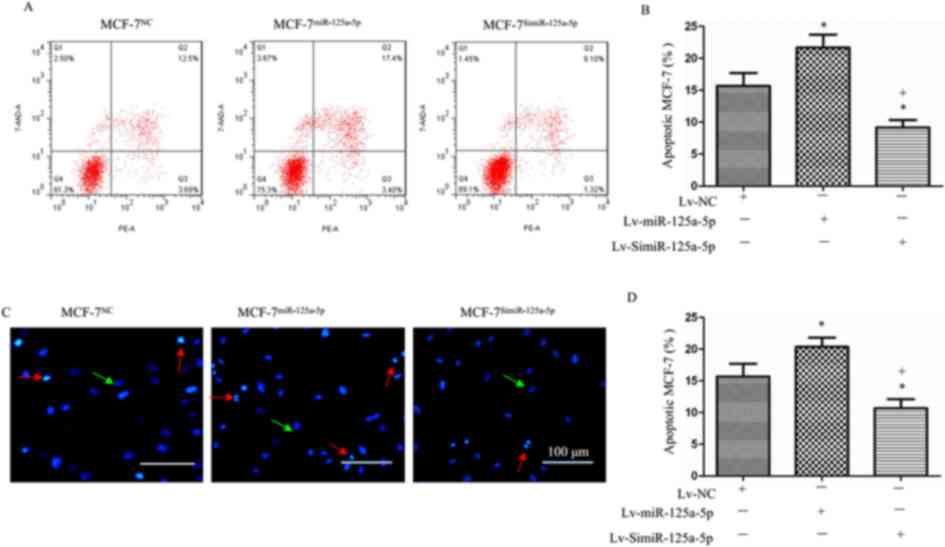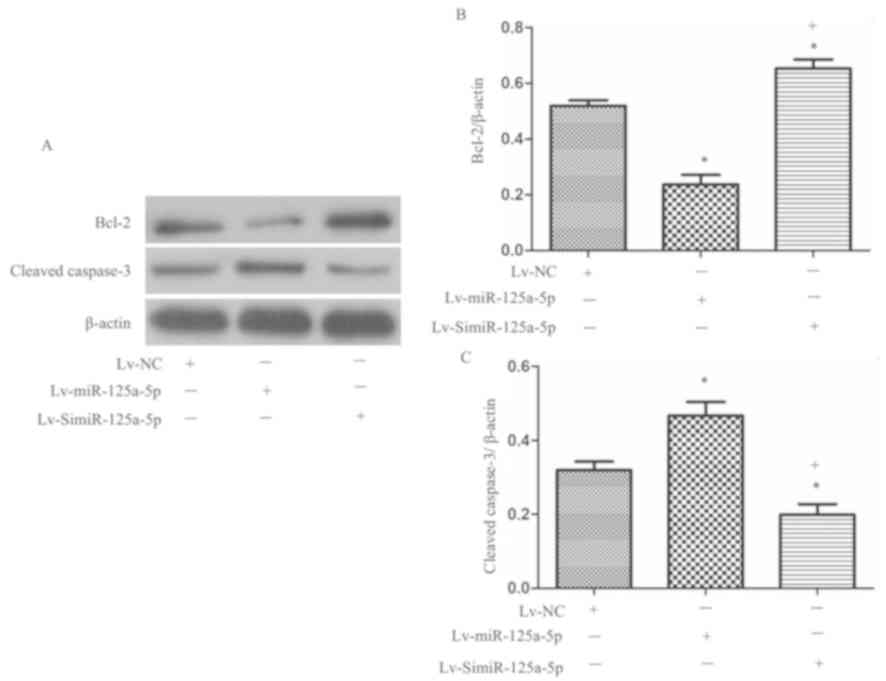MicroRNA‑125a‑5p controls the proliferation, apoptosis, migration and PTEN/MEK1/2/ERK1/2 signaling pathway in MCF‑7 breast cancer cells
- Authors:
- Published online on: September 24, 2019 https://doi.org/10.3892/mmr.2019.10704
- Pages: 4507-4514
-
Copyright: © Liang et al. This is an open access article distributed under the terms of Creative Commons Attribution License.
Abstract
Introduction
Breast cancer is one of the most common malignant tumors in females. It has the highest incidence among this population, and the age of onset is decreasing. The lifetime risk of having breast cancer is 10% in women (1). Approximately 500,000 people succumb to mortality each year from breast cancer, and the mortality rate increases by 2–3% annually (2). Early diagnosis and treatment have been particularly important in breast cancer as the options for primary prevention are limited. Identifying and studying the genes responsible for the growth and malignancy of breast cancer is critical for disease therapy.
MicroRNAs (miRs) bind to target genes involved in such pathologic processes as cell proliferation, differentiation and apoptosis, and affect their expression in the tissues and cells (3). miR-125a-5p has been reported to be abnormally expressed in prostate carcinoma (4). Various studies have shown miR-125a-5p to be closely related to tumor cell growth, differentiation and metastasis (5–7). Nevertheless, its effects on the proliferation, migration, and apoptosis of breast cancer cells and the underlying mechanisms remain unknown.
Phosphatase and tensin homolog (PTEN) is a well-characterized tumor suppressor, and it plays a key role in cell proliferation, migration and cell renewal by regulating the mitogen-activated protein kinase kinase (MEK)1/2/ERK1/2 pathway (8). The MEK1/2/ERK1/2 signal pathway and caspase-3 activation have been shown to be involved in breast cancer cell proliferation, migration and apoptosis processes (9). Studies revealed that miR-125a-5p could regulate the MEK1/2/ERK1/2 signaling pathway in multiple cell types (10,11). However, whether these proteins and pathways are involved in the mechanisms underlying miR-125a-5p regulation in breast cancer cells are unknown.
Thus, we aimed to evaluate the effects of miR-125a-5p on the biological behaviors of MCF-7 breast cancer cells and to investigate the underlying regulatory mechanisms.
Materials and methods
Cell culture and grouping
Human MCF-7 breast cancer cells were purchased from Shanghai BioLeaf Biotech. The MCF-7 breast cancer cell line was cultured in RPMI-1640 medium containing 10% fetal bovine serum (Hyclone; GE Healthcare Life Sciences), 100 U/ml penicillin, and 100 µg/ml streptomycin in an incubator with 5% CO2 and 95% humidity at 37°C. Trypsin (0.25%) was used to digest the cells when 80% of the cells adhered to the culture dish and for the subculture, which was performed every 2–3 days.
Lentiviral-mediated transfection to establish stable MCF-7 cell lines with miR-125a-5p overexpression or reduced miR-125a-5p expression
MCF-7 cells were infected with green fluorescent protein (GFP)-expressing lentivirus (1×107 multiplicity of infection) that also contained miR-125a-5p overexpression vector (LV-miR-125a-5p), miR-125a-5p silencing small interfering (si)RNA (siRNA-LV-miR-125a-5p), and a scrambled sequence (LV-NC). The medium was replaced 24 h after transfection, and the GFP-labeled cells were counted 72 h after transfection. The positive cells were screened with puromycin (final concentration of 1 mg/l) to eventually produce MCF-7 cells with miR-125a-5p overexpression (MCF-7miR-125a-5p cells), MCF-7 cells with miR-125a-5p knockdown (MCF-7SimiR-125a-5p cells), and stable LV-scramble infected MCF-7 cells (MCF-7NC), which served as the control.
Detection of miR-125a-5p expression in MCF-7 cells
The MCF-7miR-125a-5p, MCF-7SimiR-125a-5p, and MCF-7NC cells were seeded in 6-well plates. Once the MCF-7miR-125a-5p, MCF-7SimiR-125a-5p and MCF-7NC cells reached 90% confluence, total RNAs of the harvested cells were extracted using TRIzol® reagent (Thermo Fisher Scientific, Inc.) a hairpin-it™ miRs reverse transcription-quantitative PCR (RT-qPCR) kit was then used to synthesize miR-125a-5p cDNA. The RT primer sequences were human miR-125a-5p-RT (5′-GTCGTATCCAGTGCAGGGTCCGAGGTGCACTGGATACGACCTGCAG-3′); U6-RT (5′-GTCGTATCCAGTGCAGGGTCCGAGGTATTCGCACTGGATACGACAAAATATGGAAC-3′), and the reverse transcription conditions were 25°C for 30 min, 42°C for 30 min, and subsequently 85°C for 5 min. The products of RT were used as templates for PCR. The primer sequences of qPCR were 5′-ACACTCCAGCTGGGTCCCTGAGACCCTTAA-3′ (miR-125a-5p forward primer), 5′-CTCAACTGGTGTGGAGT-3′ (miR-125a-5p reverse primer), 5′-CTCGCTTCGGCAGCACA-3′ (internal reference gene U6 forward primer), and 5′-AACGCTTCACGAATTTGCGT-3′ (internal reference gene U6 reverse primer). The PCR conditions were 95°C denaturation for 3 min, 40 cycles of 95°C denaturation for 12 sec and 60°C annealing and elongation for 40 sec. The RT-qPCR procedures were performed in strict accordance with the manufacturer's instructions. Six replicate wells were performed in each group, and each experiment was performed six times. The relative expression levels of target genes were calculated using the 2−∆∆Cq method (12).
Assessment of MCF-7 cell proliferation
The harvested MCF-7miR-125a-5p, MCF-7SimiR-125a-5p and MCF-7NC cells were independently inoculated in six wells in 96-well plates (each well contained 100 µl complete cell culture medium with 2×103 cells and incubated at 37°C for 5 days. Cells were incubated in RPMI-164 + 10% FBS (HyClone; GE Healthcare Life Sciences). The viability of cells in different groups was measured daily via an MTT assay for 5 days. For the MTT assay, 20 µl MTT solution was added to each well of cells for incubation at 37°C for 4 h, followed by removal of the solution and addition of 150 µl dimethyl sulfoxide, followed by incubation at 37°C for 20 min; the absorbance was then measured at 490 nm using a microplate reader. This experiment was performed six times.
In vitro scratch assay to detect MCF-7 cell migration
The harvested MCF-7miR-125a-5p, MCF-7SimiR-125a-5p and MCF-7NC cells were independently inoculated and incubated in six-well plates (each well contained 2 ml complete cell culture medium with 5×104 cells). Each group of cells was transferred into serum-free medium once they reached 90% confluence. Then, a 200-µl pipette tip was used to scratch a straight line in the middle of the well. The scratch width in each well was measured under an inverted microscope and the measurement points were recorded. The scratch width at the same position was measured again after incubated at 37°C for 16 h. The difference between the two measurements in each well was expressed in terms of cell migration distance after 16 h. This experiment was performed six times. Quantitative analysis of migration was calculated using the following equation: (Cell-free area at 0 h-cell-free area at 16 h)/cell area at 0 h ×100%.
MCF-7 apoptosis analysis
Cell apoptosis was analyzed by Hoechst 33258 staining and an Annexin V-phycoerythrin (PE)/ 7-amino-actinomycin (7-AAD) apoptosis detection kit (BD Biosciences). The harvested MCF-7miR-125a-5p, MCF-7SimiR-125a-5p and MCF-7NC cells were independently inoculated and incubated in six-well plates (each well contained 2 ml complete cell culture medium with 5×104 cells). Once the cells reached 90% confluence, the cells were transferred to serum-free medium for 24 h incubation at 37°C to stimulate apoptosis, which was assessed using an apoptotic cell Hoechst 33258 dye kit according to the manufacturer's protocol (Beyotime Institute of Biotechnology) and observed under a fluorescence microscope (Leica Microsystems GmbH; magnification, ×400). The apoptotic cells per well were counted in five different fields of vision. The percentage of apoptotic cells per field of vision divided by the total number of cells per field of vision was obtained as the apoptotic rate.
For Annexin V-PE/7-AAD apoptosis detection, MCF-7 cells after different treatments were collected by using 0.25% trypsin and centrifuged at 200 × g at room temperature for 3 min. Cells were then washed with PBS and resuspended in 100 µl 1X annexin-binding buffer, which was included in the kit. Subsequently, 5 µl PE-conjugated Annexin V and 5 µl 7-AAD were added to the cell suspension, and incubated at room temperature for 15 min. The rate of apoptosis in MCF-7 cells was detected by flow cytometry. The cells stained only with Annexin V were considered as MCF-7 cells in early apoptosis, and those stained for both Annexin V and 7-AAD were considered as late apoptotic cells. In this study, we defined the apoptotic cells as both early and late apoptotic cells.
Western blotting analysis of protein expression
Protein extraction
After collecting the MCF-7 cells by centrifugation (200 × g and 4°C for 3 min), the MCF-7 cells were lysed with RIPA buffer (Applygen Technologies, Inc.) containing protease inhibitor and subsequently centrifuged at 13,000 × g and 4°C for 10 min to collect the supernatant (total protein) for later use.
Western blotting
The extracted proteins were separated using 12% SDS-PAGE and subsequently transferred to polyvinylidene difluoride (PVDF) membranes. The membranes were blocked at room temperature with Tris-buffered saline (TBS) containing 5% fat-free dry milk (i.e., 50 mmol/l Tris, 150 mmol/l NaCl, pH 7.6, and 5% fat-free dry milk) for 1 h. After a few washes in TBS containing 0.5% Tween-20 (TBST), the protein blots were incubated with β-actin (1:1,000; cat. no. E02102001; EarthOx), PTEN (1:1,000; cat. no. 9188S; Cell Signaling Technology, Inc.), MEK1/2 (1:500; cat. no. 4694S; Cell Signaling Technology, Inc.), ERK1/2 (1:1,000; cat. no. 4695S; Cell Signaling Technology, Inc.), B-cell lymphoma-2 (Bcl-2, 1:500, cat. no. 3498S; Cell Signaling Technology, Inc.), and caspase-3 (1:400; cat. no. 9664S; Cell Signaling Technology, Inc.) primary antibodies at 4°C overnight. After a few washes in TBST, the protein blots were incubated with 1:50,000 horseradish peroxidase (HRP)-conjugated goat-anti-mouse secondary antibodies (cat. no. 7076S; Cell Signaling Technology, Inc.) or HRP-conjugated goat-anti-rabbit secondary antibodies (cat. no. 7074S; Cell Signaling Technology, Inc.) at room temperature for 1 h. After three washes in TBST, the protein blots were developed in enhanced chemiluminescence (Amersham) substrate, and then results were analyzed under Quantity one 4.6 software (Bio-Rad Laboratories, Inc.). β-actin was used as an internal reference protein. Relative protein expression was measured based on the ratio of the target protein absorbance to the β-actin protein absorbance. This experiment was performed six times.
Statistical analysis
Data were presented as the mean ± standard deviation. Statistical analyses were performed using a t-test, one-way ANOVA followed by a least significant distance post-hoc test. GraphPad Prism 5 software (GraphPad Software, Inc.) was used for analyzing the data. P<0.05 was considered to indicate a statistically significant difference.
Results
Overexpression and knockdown of miR-125a-5p in MCF-7 cells
MCF-7 cells were labeled with green fluorescence after transfection with LV-scramble, siRNA-LV-miR-125a-5p, or LV-miR-125a-5p and selection of stable clones (Fig. 1A). The results of RT-qPCR showed that miR-125a-5p expression in the MCF-7miR-125a-5p cells was significantly higher than in the MCF-7NC cells (P<0.05; Fig. 1B); in addition, there miR-125a-5p expression was significantly reduced in the MCF-7SimiR-125a-5p cells than in MCF-7NC cells (P<0.05; Fig. 1B).
miR-125a-5p is involved in MCF-7 cell proliferation and migration
The results of the MTT assay showed the viability of MCF-7 cells in different groups. Starting from the 3rd day of experiment, the proliferation rate of the MCF-7miR-125a-5p cells was significantly lower than that of MCF-7NC cells (P<0.05; Fig. 2), while the proliferation rate of the MCF-7simiR-125a-5p cells was significantly higher than that of MCF-7NC cells (P<0.05; Fig. 2). This suggested that high miR-125a-5p expression inhibited the proliferation of MCF-7 cells, and low miR-125a-5p expression promoted this ability within MCF-7 cells.
The results of in vitro scratch assay revealed that migration ability of MCF-7miR-125a-5p cells was significantly lower than the MCF-7NC cells (P<0.05; Fig. 3A and B), while that of the MCF-7SimiR-125a-5p cells was significantly higher than the MCF-7NC cells (P<0.05; Fig. 3A and B). These results indicated that high miR-125a-5p expression inhibited the migration of MCF-7 cells. Conversely, low miR-125a-5p expression in MCF-7 cells resulted in enhanced migration of the cells.
miR-125a-5p increases PTEN/MEK1/2/ERK1/2 pathway protein expression in MCF-7 cells
PTEN protein expression in MCF-7miR-125a-5p cells was significantly higher than in MCF-7NC cells (P<0.05; Fig. 4A and B). In contrast, significantly reduced PTEN protein expression was exhibited by MCF-7SimiR-125a-5p cells compared with MCF-7NC and MCF-7miR-125a-5p cells (P<0.05; Fig. 4A and B). In addition, we found that overexpression of miR-125a-5p significantly decreased the phosphorylation levels of MEK1/2 and ERK1/2 in MCF-7 cells compared with the MCF-7NC group (P<0.05; Fig. 4A,C and D). Additionally, silencing miR-125a-5p significantly increased the phosphorylation levels of MEK1/2 and ERK1/2 in MCF-7 cells compared with the MCF-7miR-125a-5p group (P<0.05, Fig. 4A,C and D). These data suggested that the PTEN/MEK1/2/ERK1/2 signaling pathway may have contributed to the effects of miR-125a-5p on inhibiting MCF-7 cell proliferation and migration.
miR-125a-5p pomotes the apoptosis of MCF-7 cells, which is accompanied with increased cleaved caspase-3 and decreased Bcl-2 levels
Hoechst 33258 staining and flow cytometry showed that the rate of apoptosis among MCF-7miR-125a-5p cells was significantly higher than that of the MCF-7NC cells (P<0.05; Fig. 5A-D), while the apoptotic rate of the MCF-7SimiR-125a-5p cells was significantly lower than that of the MCF-7NC cells (P<0.05, Fig. 5A-D). These results indicated that high levels of miR-125a-5p promoted, while low levels of miR-125a-5p reduced the apoptosis of MCF-7 cells.
In addition, via western blotting, we monitored the levels of cleaved caspase-3 and Bcl-2, which are associated with induction of apoptosis (13). The results showed that overexpression of miR-125a-5p significantly increased cleaved caspase-3 expression, while decreased Bcl-2 expression was observed compared with the control (P<0.05; Fig. 6A-C). Silencing miR-125a-5p in MCF-7 cells revealed significantly decreased cleaved caspase-3 protein expression and increased Bcl-2 expression compared with the control and overexpression groups (P<0.05; Fig. 6A-C).
Discussion
In the present study, we found that miR-125a-5p inhibited MCF-7 migration and proliferation, but promoted apoptosis. The effects of miR-125a-5p on MCF-7 cell migration and proliferation may be associated with an increase in PTEN, and decrease in MEK1/2 and ERK1/2 protein expression, while the apoptotic effects could be associated with upregulated cleaved caspase-3 levels.
The survival time of breast cancer patients is closely related to the pathological stage of breast cancer: The earlier the pathological stage at the time of diagnosis, the higher the recovery rate (14). For this reason, and as there are currently no effective primary prevention methods, early diagnosis and treatment are particularly important in breast cancer (2,15). Mammography, ultrasonography, computed tomography, magnetic resonance imaging and biopsies are commonly used for the diagnosis of breast cancer (16). However, each diagnostic method has its limitations. Breast cancer treatments mainly include surgery, chemotherapy, radiotherapy, endocrine therapy, and biological targeted therapy (14). Although these treatments prolong patient survival, and the postoperative recurrent and metastatic rates are still relatively high, it is important to study the mechanism underlying the development and progression of breast cancer. Thus, novel therapeutic targets for breast cancer could be identified.
miRs are non-coding single-stranded small RNAs. They are ~18–25 nucleotides in length with high evolutionarily conservation (17). It binds to its target mRNAs to inhibit translation and induce degradation of the mRNA, altering the levels of expression of the target protein (18). miR-125a expression is low in breast cancer tissues, and was negatively correlated with tumor size, lymph node metastasis and clinical stage of breast cancer (19). Previous studies have reported that miR-125a is closely related to tumor cell growth, differentiation, and metastasis (20,21). A study by Scott et al (20) has shown that miR-125a downregulates human epidermal growth factor receptor 2 (ERBB2) and ERBB3 protein and mRNA expression by targeting ERBB2 and ERBB3; furthermore, miR-125a inhibited the migration and invasion of SKBR3 breast cancer cells. To the bet of our knowledge, our study, for the first time found that miR-125a-5p inhibited the proliferation and migration, and promoted the apoptosis of MCF-7 cells. Collectively, these findings demonstrated that miR-125a-5p is a candidate target for breast cancer therapy.
The MEK1/2/ERK1/2 pathway is extensively involved in the proliferation and the migration-associated protein expression of tumor cells (22), and serves an important role in tumor development and progression. A study by Hsieh et al (19) indicated that human aldo-keto reductase family 1 member B10 promotes the invasion and migration of MCF-7 cells by activating the MEK1/2/ERK1/2 pathway. Another study reported that the activation of ERK1/2/p38 MAPK signaling is involved in the regulation of invasion and metastasis of MDA-MB-231 breast cancer cells (23). These studies suggest that abnormal activation of the MEK1/2/ERK1/2 pathway may be an important mechanism underlying the development of breast cancer. In this study, MEK1/2/ERK1/2 signaling was inhibited in MCF-7 breast cancer cells with high miR-125a-5p expression. In contrast, we observed that knockdown of miR-125a-5p expression led to activation of MEK1/2/ERK1/2 signaling. PTEN, located on human chromosome 10, is a tumor suppressor gene that inhibits the growth and migration of various tumors by negatively regulating the PI3K/Akt/mTOR pathway (24,25). A recent study revealed that PTEN also inhibits the migration of type 2 endometrial cancer cells by negatively regulating the MEK1/2/ERK1/2 pathway (26). In this study, high levels of miR-125a-5p expression promoted PTEN expression in MCF-7 cells, while knockdown of miR-125a-5p expression significantly reduced PTEN expression in MCF-7 cells. This suggested that miR-125a-5p inhibited the protein expression of the MEK1/2/ERK1/2 pathway proteins by upregulating the expression of PTEN, playing a tumor suppressive role.
Caspase-3 is an important pro-apoptotic factor that plays an important role in the process of apoptosis. Bcl-2 is an important anti-apoptotic gene that serves a key role in the regulation of early apoptosis in cells (13). One recent study has shown that cyanidin-3-glucoside inhibits MDA-MB-231 breast cancer cells by promoting caspase-3 expression and downregulating Bcl-2 expression (27). In this study, we found that high miR-125a-5p expression promoted the apoptosis of MCF-7 cells, while knockdown of miR-125a-5p expression significantly lowered the rate of apoptosis among MCF-7 cells. Our study into the underlying mechanism showed that high levels of miR-125a-5p expression promoted the expression of pro-apoptotic protein, caspase-3 and inhibited the expression of anti-apoptotic protein Bcl-2. These results indicated that miR-125a-5p might be involved in regulating apoptosis in MCF-7 breast cancer cells by regulating the caspase/Bcl-2 pathway.
In summary, the present study demonstrated a potential role of miR-125a-5p in the pathogenesis of breast cancer via control of cancer cell proliferation, apoptosis and migration. In addition, our data indicated that miR-125a-5p exerted these functions in breast cancer cells by upregulating PTEN expression and inhibiting the activity of the MEK1/2/ERK1/2 pathway. However, further in-depth and in vivo investigations into the role, and the precise mechanisms underlying miR-125a-5p regulation in breast cancer should be conducted in the future.
Acknowledgements
Not applicable.
Funding
This work was supported by the Medical Scientific Research Foundation of Guangdong Province (grant no. A2018490) and the Science and Technology Innovation Fund of Guangdong Medical University (grant nos. M2015012 and M2016049).
Availability of data and materials
All data generated or analyzed during this study are included in this published article.
Authors' contributions
ZL, JL and QP designed the experiments. ZL, QP, ZZ, CH, ZY and YZ performed the experiments. ZL, JL, QP analyzed the data. ZL and QP interpreted the data. ZL and QP drafted the manuscript. JL and QP revised the manuscript. All authors read and approved the final version of the manuscript.
Ethics approval and consent to participate
Not applicable.
Patient consent for publication
Not applicable.
Competing interests
The authors declare that they have no competing interests.
References
|
Amin A, Shriver CD, Henry LR, Lenington S, Peoples GE and Stojadinovic A: Breast cancer screening compliance among young women in a free access healthcare system. J Surg Oncol. 97:20–24. 2008. View Article : Google Scholar : PubMed/NCBI | |
|
Jemal A, Ward EM, Johnson CJ, Cronin KA, Ma J, Ryerson B, Mariotto A, Lake AJ, Wilson R, Sherman RL, et al: Annual report to the Nation on the status of cancer, 1975–2014, featuring survival. J Natl Cancer Inst. 109:2017. View Article : Google Scholar | |
|
Filipowicz W, Bhattacharyya SN and Sonenberg N: Mechanisms of post-transcriptional regulation by microRNAs: Are the answers in sight? Nat Rev Genet. 9:102–114. 2008. View Article : Google Scholar : PubMed/NCBI | |
|
Fu Y and Cao F: MicroRNA-125a-5p regulates cancer cell proliferation and migration through NAIF1 in prostate carcinoma. Onco Targets Ther. 8:3827–3835. 2015. View Article : Google Scholar : PubMed/NCBI | |
|
Guo X, Wu Y and Hartley RS: MicroRNA-125a represses cell growth by targeting HuR in breast cancer. RNA Biol. 6:575–583. 2009. View Article : Google Scholar : PubMed/NCBI | |
|
Cai M, Chen Q, Shen J, Lv C and Cai L: Epigenetic silenced miR-125a-5p could be self-activated through targeting Suv39H1 in gastric cancer. J Cell Mol Med. 22:4721–4731. 2018. View Article : Google Scholar : PubMed/NCBI | |
|
Huang WK, Akçakaya P, Gangaev A, Lee L, Zeljic K, Hajeri P, Berglund E, Ghaderi M, Åhlén J, Bränström R, et al: miR-125a-5p regulation increases phosphorylation of FAK that contributes to imatinib resistance in gastrointestinal stromal tumors. Exp Cell Res. 371:287–296. 2018. View Article : Google Scholar : PubMed/NCBI | |
|
Zhang X, Jin T, Huang X, Liu X, Liu Z, Jia Y and Hao J: Effects of the tumor suppressor PTEN on biological behaviors of activated pancreatic stellate cells in pancreatic fibrosis. Exp Cell Res. 373:132–144. 2018. View Article : Google Scholar : PubMed/NCBI | |
|
Dong Q, Yang B, Han JG, Zhang MM, Liu W, Zhang X, Yu HL, Liu ZG, Zhang SH, Li T, et al: A novel hydrogen sulfide-releasing donor, HA-ADT, suppresses the growth of human breast cancer cells through inhibiting the PI3K/AKT/mTOR and Ras/Raf/MEK/ERK signaling pathways. Cancer Lett. 455:60–72. 2019. View Article : Google Scholar : PubMed/NCBI | |
|
Liang Y, Ye J, Jiao J, Zhang J, Lu Y, Zhang L, Wan D, Duan L, Wu Y and Zhang B: Down-regulation of miR-125a-5p is associated with salivary adenoid cystic carcinoma progression via targeting p38/JNK/ERK signal pathway. Am J Transl Res. 9:1101–1113. 2017.PubMed/NCBI | |
|
Pan Q, Liao X, Liu H, Wang Y, Chen Y, Zhao B, Lazartigues E, Yang Y and Ma X: MicroRNA-125a-5p alleviates the deleterious effects of ox-LDL on multiple functions of human brain microvessel endothelial cells. Am J Physiol Cell Physiol. 312:C119–C130. 2017. View Article : Google Scholar : PubMed/NCBI | |
|
Livak KJ and Schmittgen TD: Analysis of relative gene expression data using real-time quantitative PCR and the 2(-Delta Delta C(T)) method. Methods. 25:402–408. 2001. View Article : Google Scholar : PubMed/NCBI | |
|
Kluck RM, Bossy-Wetzel E, Green DR and Newmeyer DD: The release of cytochrome c from mitochondria: A primary site for Bcl-2 regulation of apoptosis. Science. 275:1132–1136. 1997. View Article : Google Scholar : PubMed/NCBI | |
|
de la Mare JA, Contu L, Hunter MC, Moyo B, Sterrenberg JN, Dhanani KC, Mutsvunguma LZ and Edkins AL: Breast cancer: Current developments in molecular approaches to diagnosis and treatment. Recent Pat Anticancer Drug Discov. 9:153–175. 2014. View Article : Google Scholar : PubMed/NCBI | |
|
Jafari SH, Saadatpour Z, Salmaninejad A, Momeni F, Mokhtari M, Nahand JS, Rahmati M, Mirzaei H and Kianmehr M: Breast cancer diagnosis: Imaging techniques and biochemical markers. J Cell Physiol. 233:5200–5213. 2018. View Article : Google Scholar : PubMed/NCBI | |
|
M Braden A, V Stankowski R, M Engel J and A Onitilo A: Breast cancer biomarkers: Risk assessment, diagnosis, prognosis, prediction of treatment efficacy and toxicity, and recurrence. Curr Pharm Des. 20:4879–4898. 2014. View Article : Google Scholar : PubMed/NCBI | |
|
Hayes J, Peruzzi PP and Lawler S: MicroRNAs in cancer: Biomarkers, functions and therapy. Trends Mol Med. 20:460–469. 2014. View Article : Google Scholar : PubMed/NCBI | |
|
Bartel DP: MicroRNAs: Target recognition and regulatory functions. Cell. 136:215–233. 2009. View Article : Google Scholar : PubMed/NCBI | |
|
Hsieh TH, Hsu CY, Tsai CF, Long CY, Chai CY, Hou MF, Lee JN, Wu DC, Wang SC and Tsai EM: miR-125a-5p is a prognostic biomarker that targets HDAC4 to suppress breast tumorigenesis. Oncotarget. 6:494–509. 2015. View Article : Google Scholar : PubMed/NCBI | |
|
Scott GK, Goga A, Bhaumik D, Berger CE, Sullivan CS and Benz CC: Coordinate suppression of ERBB2 and ERBB3 by enforced expression of micro-RNA miR-125a or miR-125b. J Biol Chem. 282:1479–1486. 2007. View Article : Google Scholar : PubMed/NCBI | |
|
Liu X, Du L and Feng R: c-Src regulates cell cycle proteins expression through protein kinase B/glycogen synthase kinase 3 beta and extracellular signal-regulated kinases 1/2 pathways in MCF-7 cells. Acta Biochim Biophys Sin (Shanghai). 45:586–592. 2013. View Article : Google Scholar : PubMed/NCBI | |
|
Jafari SM, Joshaghani HR, Panjehpour M and Aghaei M: A2B adenosine receptor agonist induces cell cycle arrest and apoptosis in breast cancer stem cells via ERK1/2 phosphorylation. Cell Oncol (Dordr). 41:61–72. 2018. View Article : Google Scholar : PubMed/NCBI | |
|
Düzgün ŞA, Yerlikaya A, Zeren S, Bayhan Z, Okur E and Boyacı İ: Differential effects of p38 MAP kinase inhibitors SB203580 and SB202190 on growth and migration of human MDA-MB-231 cancer cell line. Cytotechnology. 69:711–724. 2017. View Article : Google Scholar : PubMed/NCBI | |
|
Mashayekhi S, Yousefi B, Tohidi E, Darband SG, Mirza-Aghazadeh-Attari M, Sadighparvar S, Kaviani M, Shafiei-Irannejad V, Kafil HS, Karimian A, et al: Overexpression of tensin homolog deleted on chromosome ten (PTEN) by ciglitazone sensitizes doxorubicin-resistance leukemia cancer cells to treatment. J Cell Biochem. 120:15719–15729. 2019. View Article : Google Scholar : PubMed/NCBI | |
|
Ocana A, Vera-Badillo F, Al-Mubarak M, Templeton AJ, Corrales-Sanchez V, Diez-Gonzalez L, Cuenca-Lopez MD, Seruga B, Pandiella A and Amir E: Activation of the PI3K/mTOR/AKT pathway and survival in solid tumors: Systematic review and meta-analysis. PLoS One. 9:e952192014. View Article : Google Scholar : PubMed/NCBI | |
|
Xiong S, Cheng JC, Klausen C, Zhao J and Leung PC: TGF-β1 stimulates migration of type II endometrial cancer cells by down-regulating PTEN via activation of SMAD and ERK1/2 signaling pathways. Oncotarget. 7:61262–61272. 2016. View Article : Google Scholar : PubMed/NCBI | |
|
Cho E, Chung EY, Jang HY, Hong OY, Chae HS, Jeong YJ, Kim SY, Kim BS, Yoo DJ, Kim JS and Park KH: Anti-cancer effect of cyanidin-3-glucoside from mulberry via caspase-3 cleavage and DNA fragmentation in vitro and in vivo. Anticancer Agents Med Chem. 17:1519–1525. 2017. View Article : Google Scholar : PubMed/NCBI |



